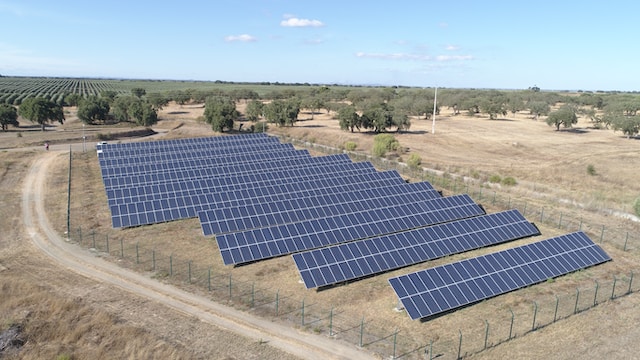
The sun, our greatest source of energy, has been powering our planet’s life systems for millions of years. However, it wasn’t until recently that we discovered how to harness the true power of the sun. Solar power is the most abundant and renewable source of energy on our planet, and it is rapidly transforming the way we power our homes, businesses, and industries.
Solar power is a clean and sustainable energy option that doesn’t release harmful pollutants or greenhouse gases into the air. It can help reduce our reliance on fossil fuels, which are rapidly depleting and have detrimental impacts on our environment. With solar power, we can significantly reduce our carbon footprint and mitigate the effects of climate change.
Understanding Solar Power
Solar power is a fascinating and revolutionary form of clean energy that utilizes radiant light and heat from the sun to generate electricity. In this section, we will delve deeper into the intricacies of solar power, explore the science behind it, and understand how solar panels work.
How Solar Panels Work
Solar panels are composed of photovoltaic (PV) cells, which convert sunlight into direct current (DC) electricity. Here’s a breakdown of the key steps involved in the process:
Absorption of Sunlight:
When sunlight hits the solar panels, the photovoltaic cells within them absorb the energy from photons (particles of light). This energy excites the electrons within the cells, creating an electric current.
Creation of Electric Current:
The excited electrons flow through an electric circuit within the solar panels, generating a direct current (DC) of electricity. However, most household appliances and power grids utilize alternating current (AC) electricity. Therefore, an inverter is typically used to convert the DC electricity produced by the solar panels into AC electricity.
Usage or Storage of Electricity:
At this stage, the converted AC electricity can either be used to power appliances directly or be stored in batteries for later use. This capability to store excess electricity in batteries is particularly useful for times when there is limited sunlight, such as during nighttime or cloudy days.

Benefits of Solar Power
Solar power offers numerous advantages over conventional energy sources. Here are some key benefits:
- Renewable and Sustainable
Unlike fossil fuels, which are finite resources, solar power is entirely renewable. As long as the sun continues to shine, we can harness its energy. This makes solar power a sustainable solution and reduces our dependence on fossil fuels, helping to combat climate change.
- Mitigation of Air Pollution
Solar power systems produce electricity without emitting harmful pollutants, such as greenhouse gases or particulate matter. By adopting solar energy, we can significantly reduce air pollution and improve air quality, leading to healthier environments and better overall public health.
- Cost Savings in the Long Run
Though the upfront costs of installing solar panels may seem high, solar power can save you money in the long run. Over time, the electricity produced by solar panels can offset or even eliminate your monthly utility bills. Furthermore, the investment in solar panels often pays for itself through reduced energy costs and potential government incentives.
- Job Creation and Economic Growth
The widespread adoption of solar power has the potential to create new job opportunities and foster economic growth. As the demand for solar panels and solar-related industries increases, more skilled workers will be needed, leading to job creation and technological advancements in the field.

Solar Power’s Role in Reducing Greenhouse Gas Emissions
As we continue to grapple with the effects of climate change, the significance of solar power in reducing greenhouse gas emissions cannot be overstated. By harnessing the immense energy of the sun, solar power offers a viable solution to curbing the release of harmful pollutants into our atmosphere. Let us explore the ways in which solar power contributes to the reduction of greenhouse gas emissions, thereby mitigating the impact of climate change.
Clean and Renewable Energy
Solar power is an environmentally friendly alternative to fossil fuel-based energy sources. Unlike the burning of coal, oil, or natural gas, solar power does not release carbon dioxide (CO2) or other greenhouse gases into the atmosphere during operation. By utilizing solar energy, we can steadily decrease our reliance on fossil fuels and transition towards a more sustainable and cleaner energy system.
Zero Emissions During Operation
When solar panels convert sunlight into electricity, they do not emit any greenhouse gases or harmful pollutants. This directly contrasts with traditional power plants that rely on the combustion of fossil fuels, which release significant amounts of CO2, methane (CH4), and other greenhouse gases. By embracing solar power, we can significantly diminish the carbon footprint associated with electricity production.
Reduction in Carbon Footprint
The adoption of solar power on a large scale has the potential to substantially reduce our overall carbon footprint. Traditional electricity generation methods heavily contribute to global greenhouse gas emissions, contributing to the rise in global temperatures and influencing climate patterns. Solar power provides an opportunity to transition to a low-carbon economy and secure a sustainable future for generations to come.
Offset Emissions and Energy Consumption
Solar power systems offer the possibility of generating surplus electricity during times of peak sunlight, which can be exported back to the grid. This surplus energy offsets the need for power generated by fossil fuel-based sources, further reducing greenhouse gas emissions. Additionally, individuals and businesses can install solar panels to meet their own energy needs, minimizing their reliance on emissions-intensive energy sources.
INTEGRATION WITH ENERGY STORAGE SOLUTIONS

One of the main challenges with solar power has been its intermittent nature, as it depends on the availability of sunlight. However, advancements in energy storage technologies, such as battery systems, have revolutionized the efficiency and reliability of solar power. Energy storage allows excess solar energy to be stored for use during times of low sunlight, ensuring a continuous supply of clean electricity without the need for backup power sources that contribute to greenhouse gas emissions.
The Solar Revolution: Global Growth and Adoption
As the world continues to recognize the urgent need for sustainable energy solutions, solar power has emerged as a front-runner in the race towards a greener future. The global growth and adoption of solar technology have been nothing short of a revolution, transforming the way we generate and consume electricity. In this section, we will explore the remarkable progress made in the solar industry, the factors contributing to its widespread adoption, and the benefits it offers on a global scale.
The Rise of Solar Power
Solar power has gained significant momentum in recent years, propelled by its status as a renewable energy champion. The abundance of sun-drenched regions across the globe makes solar energy a universally accessible resource. As a result, solar power has experienced exponential growth, with countries around the world embracing its potential to meet their growing energy demands sustainably.
Government Support and Incentives
Numerous governments worldwide have recognized the importance of transitioning to clean energy sources, leading them to implement policies and incentives to encourage solar adoption. These measures range from feed-in tariffs, tax credits, and grants to favorable regulations and streamlined permit processes. Government support has played a crucial role in driving solar market growth and attracting investment.
Technological Advancements
Innovation has been a key driver of the solar revolution. Breakthroughs in solar panel efficiency, energy storage systems, and manufacturing processes have greatly improved the viability and affordability of solar power. Efforts to develop new materials, such as perovskite solar cells, hold promise for even greater efficiency gains in the future.
Global Solar Power Leaders
China:
China has emerged as the global leader in solar power, both in terms of production and installation capacity. The country’s commitment to reducing its reliance on coal and combating air pollution has propelled its rapid expansion in the solar industry. Chinese solar manufacturers have driven down costs, making solar power more affordable and accessible worldwide.
United States:
The United States has witnessed remarkable growth in its solar industry, fueled by a combination of federal and state-level initiatives. Market incentives, such as the Investment Tax Credit (ITC) and Renewable Portfolio Standards (RPS), have encouraged widespread adoption. Several states, including California and Texas, have become solar powerhouses, boasting impressive installation capacities.
India:
India, with its abundant solar resources and burgeoning demand for electricity, has become a major player in the global solar market. The Indian government’s commitment to increasing the share of renewable energy in its energy mix has resulted in significant deployment of solar installations. The Solar Energy Corporation of India (SECI) has been instrumental in facilitating large-scale solar projects across the country.

Benefits of Global Solar Adoption:
- Energy Independence and Security
The widespread adoption of solar power enhances energy independence by diversifying countries’ energy sources. Reliance on fossil fuel imports can be reduced, reducing vulnerability to price fluctuations and geopolitical tensions. Solar power also provides decentralized energy solutions, empowering communities to generate their own electricity.
- Job Creation and Economic Growth
The solar revolution has created a wealth of job opportunities, driving economic growth in both established and emerging markets. Installations, manufacturing, research and development, and maintenance of solar systems all contribute to job creation, supporting local economies and long-term sustainability.
- Environmental Preservation
By shifting to solar power, nations can significantly reduce their carbon footprints and mitigate the impacts of climate change. Solar energy produces zero greenhouse gas emissions during operation, leading to cleaner air, improved public health, and the preservation of ecosystems.
Advancements in Solar Technology
Over the past few decades, remarkable advancements in solar technology have revolutionized the efficiency, affordability, and versatility of solar power. These breakthroughs have not only propelled the widespread adoption of solar energy but also paved the way for a sustainable future. In this section, we will explore the innovative technologies and developments that have shaped the solar industry, making it one of the fastest-growing sources of clean energy worldwide.
High-Efficiency Solar Panels:
Monocrystalline Silicon Cells:
Monocrystalline silicon solar cells represent a significant leap forward in solar panel technology. These cells are made from a single crystal structure, ensuring higher efficiency and power output compared to other types of cells. Monocrystalline panels offer excellent performance in limited space and perform well under low light conditions, making them ideal for residential and commercial installations.
Polycrystalline Silicon Cells:
Polycrystalline silicon cells, also known as multicrystalline or multi-Si cells, have become a popular alternative to monocrystalline cells. These cells are made by melting and solidifying multiple fragments of silicon.
While they may have slightly lower efficiency than monocrystalline cells, they are more cost-effective to manufacture, making them a viable option for large-scale installations.

Thin-Film Solar Cells:
Thin-film solar cells are a promising development in the solar industry, offering flexibility, lightweight design, and lower manufacturing costs. These cells are made by depositing thin layers of photosensitive materials onto a variety of substrates, such as glass or flexible materials like plastic. Thin-film technology has the potential to revolutionize solar applications by allowing integration into unconventional surfaces like curved structures and clothing, expanding the possibilities for solar power generation.
Concentrated Solar Power (CSP):
Concentrated Solar Power, or CSP, utilizes mirrors or lenses to concentrate sunlight onto a small area, converting it into heat. This heat is then used to produce electricity through various processes, such as steam turbines or Stirling engines. CSP offers the advantage of being able to store excess heat, allowing for continuous power generation even when the sun isn’t shining. Large-scale CSP plants have been built in areas with high solar radiation, providing clean and reliable energy to communities.
Building-Integrated Photovoltaics (BIPV):
Building-Integrated Photovoltaics, or BIPV, integrates solar panels seamlessly into the design of buildings, making them an integral part of the structure. BIPV technology covers various elements, including solar windows, solar roof tiles, and solar facades.
This integration not only generates renewable energy but also enhances the aesthetics of buildings. BIPV holds immense potential for reducing carbon emissions in the construction sector and transforming our cities into sustainable hubs.

Perovskite Solar Cells:
Perovskite solar cells are a recent discovery in solar technology that has generated significant excitement in the scientific community. These cells are made from a unique class of materials known as perovskites, which can be processed into thin, lightweight, and highly efficient solar cells. Perovskite solar cells offer the potential for low-cost production, high power conversion efficiency, and flexibility in design. While still in the experimental stage, perovskite solar cells show immense promise for revolutionizing the solar industry.
Advancements in solar technology have propelled the solar industry into a new era of efficiency, affordability, and versatility. From high-efficiency monocrystalline and polycrystalline panels to thin-film solar cells and concentrated solar power systems, there is a wide range of technological innovations driving the widespread adoption of solar energy. Additionally, the integration of solar panels into building materials and the development of perovskite solar cells demonstrate the ever-expanding potential of solar power. With continuous research and development, solar technology will continue to evolve, creating a sustainable future powered by the sun.


